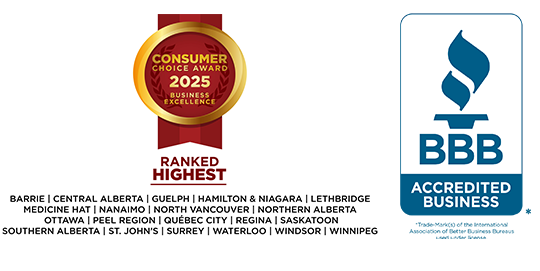Everything you need to know about retiring debt free
It’s never too early, or too late, to work towards becoming debt free, especially as you approach retirement.
Canadian adults of all ages struggle with debt, but for seniors approaching retirement, the burden of debt can feel much heavier.

You’ve worked for decades and now is the time to reap the rewards of your hard work and relax. But bringing debt of any size with you into retirement can add unnecessary stress.
In planning for retirement, it’s important to prioritize paying off your debts. This will look different for each person but having a handle on what you owe, and a plan to pay it off, will give you the peace of mind to realize your retirement dreams without the financial pressure of a heavy debt load.
Whether you’re looking to get a head start on tackling your debts alone or are seeking out the help of a Licensed Insolvency Trustee (LIT), there are a few things you’ll need to consider when planning for a debt-free retirement.
Am I financially ready to retire?
None of us can predict the future but we can plan ahead. When it comes to retirement, how you’ll manage financially is an incredibly important part of the puzzle.
Thorough and thoughtful planning, budgeting, and saving will give you the tools you’ll need to be able to support yourself and your goals without having to worry about debt impacting or pushing back your retirement.
There are a few key things to consider when getting started on a retirement plan:
- What will my income be?
- As we know, with retirement comes a significant decrease in income. Living on a smaller, fixed budget can be challenging. Savings, debt, pensions, RRSPs, and government benefits all need to be considered when looking at what your financial situation will be post-retirement.
- How will my expenses change?
- Depending on your situation, some expenses will certainly decrease post-retirement. No longer having to commute for work may bring some costs down but the cost to repay your debts will remain the same and may even increase if your principal keeps building. Will your benefits coverage change after retirement, are you planning on moving and selling your home? These are all things that our team of advisors can help you assess to map the best path forward.
- What is my current debt situation?
- Planning for retirement means taking a hard look at your financial situation, debts and all. Are your debts manageable, even after your income goes down? Or are you already overwhelmed by debt ahead of retirement? Consider what being debt free would mean for your retirement and create a financial plan that helps you achieve that goal.
- What do I want to do in retirement?
- Knowing how you want to spend your retirement is key to knowing how much you’ll need to fund it. Your retirement goals don’t have to be pipe dreams. Working with one of our advisors can help you come up with a plan for what you want to do in retirement and the financial resources you’ll need to get there and stay there, comfortably.
Debt can make retirement seem unachievable or scary but there are steps you can take to help mitigate the impact of your debt on your retirement goals.
Budgeting, saving, and having realistic targets and timelines are all part of a system that will enable you to live happily after retirement.
Planning for a debt-free retirement
Regardless of your age or stage in life, planning for retirement is a must. Consider what you want the last 10, 20, 30 years of your life to look like and create a detailed outline. Think of a retirement plan as a fluid set of goals that gives you the freedom to make changes as your situation becomes clearer.
Here are a few things to consider when putting together a retirement plan:
- Timeline: When do you want to retire? Come up with a specific date to work towards and work back from. Depending on how close you are to that date, you’ll want to set debt repayment goals. You’ll also need to determine when you’ll start drawing from the Canada Pension Plan and Old Age Security benefits. You can access CPP at 60 and Old Age Security at 65 but can defer both until you’re 70. The longer you wait to take from them, the more money you’ll receive.
- Income: Decide how much you’ll need to maintain a realistic standard of living throughout your retirement. Calculate your anticipated monthly expenses post-retirement and multiply that by the number of years you expect to live after retirement to get a rough estimate. Then divide that number by the number of years between now and your expected retirement date and divide that by 12. That’s the amount you’ll need to save each month to reach your retirement goal.
- Budget: How do you plan to hold yourself to your timeline and savings goals? A budget is a helpful tool to keep you accountable of your spending in retirement, and when you know what your income will look like for years to come, helps you build a routine. You’ll want to consider what an emergency fund might look like and how that could change depending on health care or housing expenses post-retirement.
- Real estate and investments: Many seniors will downsize their homes in retirement, a move that could also help pay down significant debts and reduce overall housing expenses. If you have investments, diversify your portfolio to minimize risk and maximize returns. Consult a financial advisor to help make informed decisions about what those changes might look like.
What are my options?
If your debt is getting in the way of your retirement plans, it’s time to speak with an MNP Licensed Insolvency Trustee to better understand the options available to you for debt solutions, and what might be the best choice.
A Consumer Proposal or Bankruptcy are options that offer the most relief from crippling debt with the ability to individualize each approach to your unique situation.
A Consumer Proposal could be preferable for seniors who struggle to make ends meet who have assets, such as a home, they don’t want to lose. Whereas Bankruptcy might be the best choice for seniors who don’t own a home and aren’t worried about needing to build back their credit. Both options have their benefits and downsides, depending on your current financial situation.
Taking the first step can often be the hardest part of the process but getting a handle on your debts ahead of retirement doesn’t have to be scary and you don’t have to do it alone.


